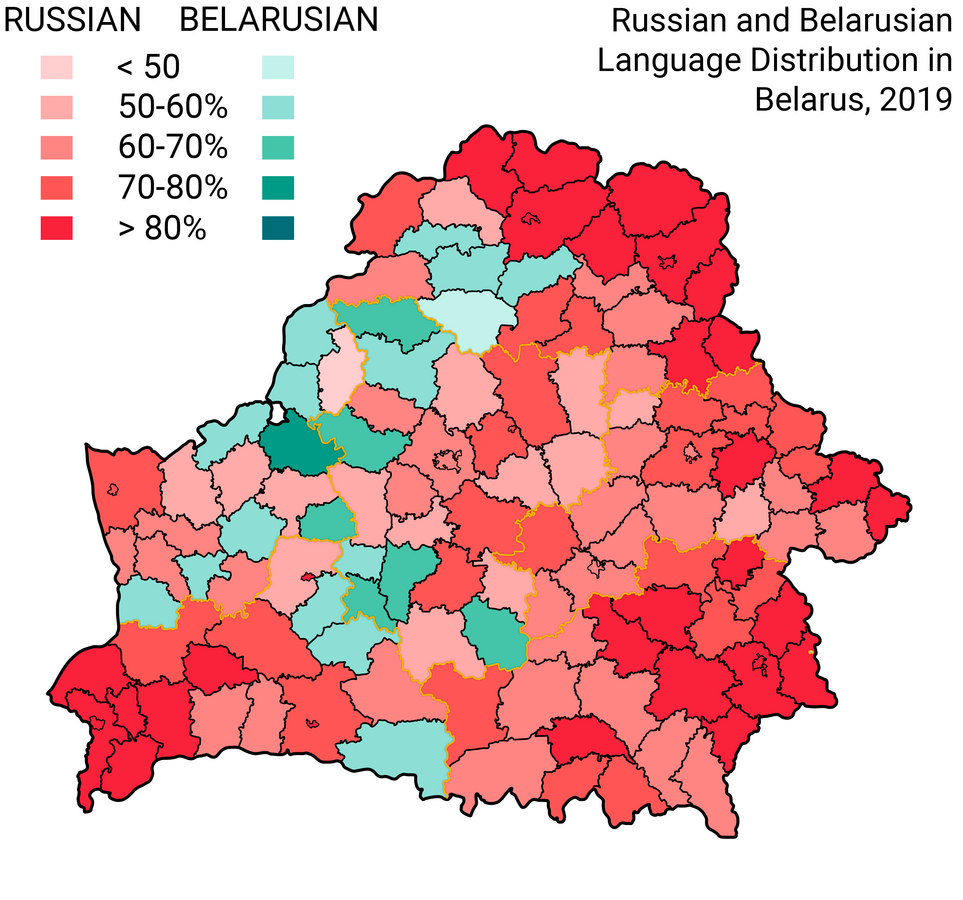Languages Spoken in Belarus Map


Marcus Rodriguez
Historical Geography Expert
Marcus Rodriguez specializes in historical cartography and geographic data analysis. With a background in both history and geography, he brings unique...
Geographic Analysis
What This Map Shows
This map provides a comprehensive overview of the languages spoken across Belarus, highlighting both the prevalence and geographical distribution of various languages throughout the country. Belarus is a nation where language serves not only as a means of communication but also as a bearer of cultural identity and social cohesion. The primary languages depicted on this map are Belarusian and Russian, with others like Polish, Ukrainian, and Yiddish also represented in specific regions. Understanding the linguistic landscape of Belarus helps us appreciate the country's rich cultural tapestry and the dynamics of its society.
Deep Dive into Languages in Belarus
Belarus is a fascinating case when it comes to language. The two official languages, Belarusian and Russian, coexist in a unique bilingual environment. According to the 2019 census, about 23% of the population speaks Belarusian as their primary language, while a significant majority, approximately 70%, uses Russian in daily communication. This linguistic division isn't merely statistical; it reflects historical, political, and cultural influences shaping the nation over centuries.
Interestingly, Belarusian, a language belonging to the East Slavic group, has its roots deeply entrenched in the history of the Belarusian people. Despite being an official language, its use has been declining in urban areas, where Russian dominates. In rural regions, however, Belarusian remains more prevalent, illustrating a cultural divide that is both geographic and generational. The resurgence of interest in Belarusian culture and language has sparked movements aimed at revitalizing its usage in schools, media, and public life.
The Russian language, on the other hand, has historically been a significant part of Belarusian identity, especially during the Soviet era when it was promoted extensively. Today, it's not only the most widely spoken language but also serves as a lingua franca, bridging communication among the diverse ethnic groups residing in the country.
Beyond these two dominant languages, Belarus is home to various minority languages. For instance, Polish is primarily spoken in the western regions, particularly in areas close to the border with Poland, like the Grodno region. This is a reflection of historical ties and the presence of Polish communities. Similarly, Ukrainian and Yiddish can be found in certain pockets, showcasing the multicultural aspect of Belarusian society. The existence of these languages underscores the importance of preserving cultural heritage amidst the prevailing dominance of Belarusian and Russian.
Regional Analysis
Breaking down the map by regions reveals distinct linguistic patterns across Belarus. In the capital city, Minsk, Russian is overwhelmingly the dominant language, with most urban residents opting for it in both social and professional settings. Interestingly, Minsk is also a hub for Belarusian cultural events, indicating a growing interest in promoting the Belarusian language among the younger population.
In contrast, the Brest and Grodno regions present a fascinating case. Here, you will find a significant Polish-speaking population, particularly in the vicinity of the Polish border. The presence of Polish schools and cultural organizations in these areas highlights the ongoing use of Polish as a vital part of local identity. Conversely, the Mogilev and Vitebsk regions exhibit a higher concentration of Belarusian speakers, especially in rural communities, where traditional customs and the local dialects remain strong.
This geographical linguistic variety reflects not only the historical migrations and demographics but also the modern-day influences of globalization and urbanization. For instance, while urban areas lean heavily towards Russian, rural regions tend to maintain their linguistic traditions, creating a rich, diverse linguistic landscape.
Significance and Impact
Understanding the linguistic distribution in Belarus is crucial for several reasons. It highlights the interplay between language and identity, particularly in a country that has experienced significant political and social changes over the past few decades. Language is often seen as a cornerstone of cultural identity; thus, the dominance of Russian in urban areas poses challenges for the preservation of Belarusian culture.
Moreover, the current trends indicate a growing movement towards language revival and cultural nationalism, particularly among the youth. This shift could have profound implications for the future of language policies in Belarus, potentially leading to more support for the Belarusian language in education and public life.
As globalization continues to influence local cultures, the linguistic situation in Belarus will be an important area to watch. The ongoing dialogue about language use in public spaces will likely shape Belarusian society's future, as the balance between preserving heritage and embracing modernity is navigated. Ever wondered how this balance will evolve in the coming years? The answer lies in the hands of the next generation, who will determine the cultural narrative of Belarus moving forward.
Visualization Details
- Published
- October 1, 2025
- Views
- 48
Comments
Loading comments...